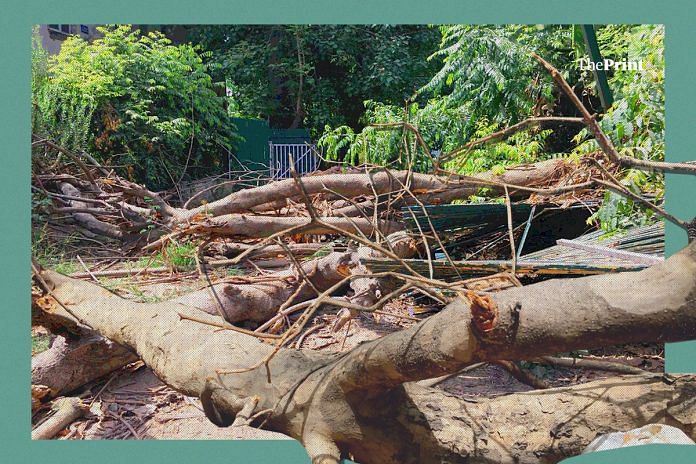Nearly 16,500 trees in Delhi are set to be uprooted as part of a redevelopment plan. Union minister for housing and urban affairs, Hardeep Singh Puri, called critics of the plan ‘mischief mongers’ who are ‘peddling a fake narrative’. Environmentalists attribute this blatant violation of rules to unscientific ways of pruning.
Delhi High Court Monday stayed the felling of trees till 4 July.
ThePrint asks: Is Delhi being paranoid or realistic about the cutting of thousands of trees?
If you look at city as commercial venture, you can cut as many trees you want
 Gautam Bhatia
Gautam Bhatia
Architect
Cutting trees will lead to a terrible ecological disaster. Trees should be saved, and there’s nothing sentimental about it. Trees can’t really be replaced.
Besides ecology, there is a much larger question on how our cities are being developed. Does development mean that more people need to be housed in lesser space? If not, then why are we doing this?
Large chunks of city centres are being reconceptualised in Delhi, Mumbai’s Bandra, and Bengaluru’s Indira Nagar. We need serious answers to these questions.
Not everything can be converted into a commercial venture. If you look at the city as a commercial venture, and not a place for communities, then you can cut as many trees as you want. Once you detach those values, you can turn everything into a shopping mall.
These places in Delhi, if they have been viewed as experiments on how India ought to live, need serious thought. This is a chance to take the development-ecology angle head-on. It can help reconceive what can and should be built in these spaces.
We need to find new ways to design homes. It may require creating a completely vehicle-free housing zone, or creating a central water reservoir to meet water shortage. Cities abroad have forests at the centre and housing zones are created around them.
The approach to accommodate 50,000 houses in four-hectare land is short-sighted. We need newer, fresher ideas but we don’t seem to be heading in that direction.
Indiscriminate massacre of trees will aggravate air pollution in Delhi
 Padmavati Dwivedi
Padmavati Dwivedi
Founder, Compassionate Living
As an environment activist, I have been sensing a growing discontent and anger in society against the felling of trees. The rising air pollution poses serious health hazards to the residents of south Delhi. Trees provide a host of environmental and ecological benefits, and are the sole natural entities that mop up poisonous gases in Delhi.
The indiscriminate massacre of trees will aggravate the situation. This should be reason enough for Delhiites to raise their voice against the unnecessary cutting of mature trees.
The alternative solutions of transplanting and compensatory plantation have not been successful either. The trees that are planted back are not of local origin and therefore not suited to the extreme climatic conditions of Delhi. Hence, people are not buying these alternatives.
Delhiites who have earlier been involved in tree protection drives did not get much help from the agencies. However, I believe that they would happy to get an opportunity to join the protest.
Personally, I don’t think Delhi can manage the rising pollution levels by losing mature old trees in such huge numbers. So, the hue and cry over tree cutting is far from being a paranoia. It is a real crisis which must be addressed.
Project must go back to the drawing board & include more standing trees
 Chetan Agarwal
Chetan Agarwal
Independent environment analyst, Senior fellow Centre for Ecology Development and Research (CEDAR)
Delhi is one of India’s greenest cities, largely due to the presence of the Aravalli range and the planned green colonies in central and south Delhi. The redevelopment of seven government housing colonies in south Delhi will deal a blow to the city’s green cover. A quick look at the Environment Impact Assessment (EIA) report for one of the projects– Netaji Nagar– reveals that on a proposal to cut 76 per cent of the existing trees, permission has been given to cut 64 per cent of them. The Netaji Nagar site has 3,900 trees with 73 species in all.
This is an extraordinarily high percentage of tree felling for a site with a relatively low building footprint of only 25 per cent of the total area. The EIA report states that 41 per cent of the area will be earmarked for open spaces and green belts.
The report does not, however, provide a high-resolution map of the location of the trees and their canopy cover. It seems that an existing tree-map may not have been prepared, which could have helped authorities to build around these trees rather than over them.
Urban trees provide multiple benefits to city residents, including controlling air pollution, providing shade, reducing the heat-island effect, and providing a habitat for birds and small animals.
On continuum of green cover, Netaji Nagar was closer to Lutyens’ Delhi. The current proposal will now move it closer to Sangam Vihar. The project should go back to the drawing board and incorporate more standing trees. trees. Guidelines for urban redevelopment projects should be prepared by MOUD and MoEFCC which
require mapping of existing tree cover and provide case-studies of sensitive redevelopment. Successive future generations of government officers, their families and children, and citizens deserve better.
If saving Delhi’s ecosystem is paranoia, it is a valid one
 Devlina Kohli
Devlina Kohli
Part of SaveDelhiSOS and MyRightToBreathe
We don’t have to go into the statistics of the whole ‘tree game’. Just look at the aerial views on Google Maps for East and West Kidwai Nagar, and then compare them with those for Lutyens’ Delhi. The contrast is stark.
It seems that the powers that be, political or commercial, desire to live in areas with green cover. What is it that gives one set of people the right to enjoy the benefits of a green cover – fresher air, less pollution, wet soil, less flooding, flora and fauna with small ecosystem of plants – while denying them to the majority of the population? Aren’t we a democratic country?
Temperatures are on the rise because we don’t have enough green cover; desertification of Delhi is increasing because we continue to remove the green wall of trees all over Delhi and rest of north India. When it rains, among other things, the lack of trees to fix the topsoil and absorb water leads to a host of problems.
If you ask the ‘aam aadmi’ who doesn’t have an air-conditioned car and depends on buses, two-wheelers or walking, s/he will tell you that the green avenues of New Delhi are the most desirable places for them to move around in.
Are we creating an unnecessary hype over cutting of a few thousand trees? No. Because what is going to replace them is clearly a commercialised, dystopian plan that consists of high-rises, palm trees and anti-glare glass buildings. It will lead to more heat, more pollution, more health issues, more deaths, and will eventually kill Delhi’s ecosystem.
If that is paranoia, it is a valid one.
Our ministers don’t know the difference between tree cover and green cover
 Anil Sood
Anil Sood
Founder of Chetna NGO
Union minister of state for housing and urban affairs Hardeep Singh Puri’s statement on Twitter about critics of the redevelopment plan ‘peddling a fake narrative’ is false. He does not know the difference between tree cover and green cover. In simple words, green cover includes ornamentation with fancy trees and flowers of foreign origin, and is redundant.
Delhi airport, for instance, has plenty of green cover but not sufficient tree cover. The moment a dust storm comes, airport operations are shut down.
Greening of the city for ornamentation does not serve any environmental purpose. This is, in fact a flawed concept of afforestation.
We all know that tree plantation reduces noise pollution, creates a barrier for dust pollution, acts as a shelter for birds, and recharges the existing water table. Now imagine that the trees are chopped off in area A. Ministers plant ornamental trees in the name of afforestation in area B. Do you think that it is practical for residents of area A to move to area B where they have planted decorative trees?
In addition to green cover, tree cover also has to be maintained. The former serves no purpose in isolation. Ever since the tree cover in south Delhi has depleted, there have been more instances of dust storms here. Alarmingly, these dust storms do not result in sufficient rainfall for the city.
It is the hallmark of good governance to consult citizens before such massive projects
 Kanchi Kohli and Manju Menon
Kanchi Kohli and Manju Menon
Researchers at Centre for Policy Research, New Delhi
For the last 10 days, Delhi’s citizens have brought to light the follies of a massive ‘redevelopment’ project that would lead to felling of over 14,000 trees. This initiative has brought together concerned residents, ecologists, nature enthusiasts and anti-pollution campaigners to save Delhi’s green spaces. With the air pollution crisis no longer a seasonal episode, trees are even more critical for an urban metropolis like Delhi.
Due to these efforts, the basic data on tree count, the government’s justification for the project and the alleged illegalities have come to light. Neither the central nor the state government took any steps to disclose the details of the project design or the trade-offs involved. All these projects have a commercial real estate component other than housing for government officials. Even if the law does not mandate disclosure, it is the hallmark of good governance to consult citizens if a massive land use change of this nature is planned.
Citizens are merely appealing to their government for more information and better development. The only response so far from the ministry of housing and urban development, that the tree loss will be compensated for through plantations, is not useful. Citizens have rejected this argument because there is enough evidence to show the failure of compensatory afforestation across the country. The CAG’s 2018 report concluded that the shortfall in compensatory plantations in Delhi from 2014-17 was as high as 67 per cent.
Compiled by Deeksha Bhardwaj and Prerna Chatterjee.







Fantastic article! Please continue to keep the spotlight on the issue. Because, in my motherland today, actions don’t match the rhetoric anymore.
In India nowadays we see an increasing trend of the powerful leaders bulldozing the rights, sentiments of the common man. Greed has replaced need and the common man, the voter is not important anymore.
Common sense it seems is not so common anymore – especially for our policymakers. Which is why, even as schoolkids are taught to Save Trees, the policymakers think nothing of chopping them.
Well said.
The campaign to save trees and increase green cover in Delhi should be intensified.